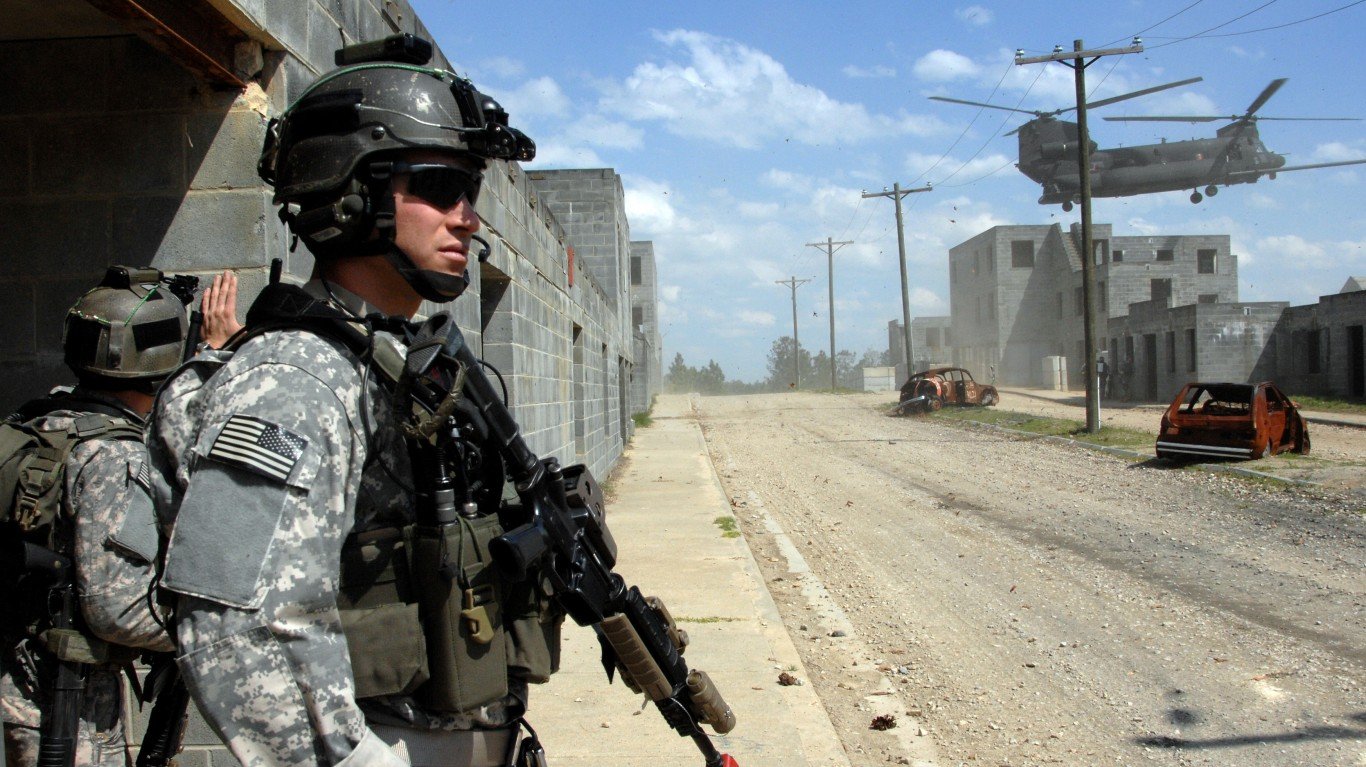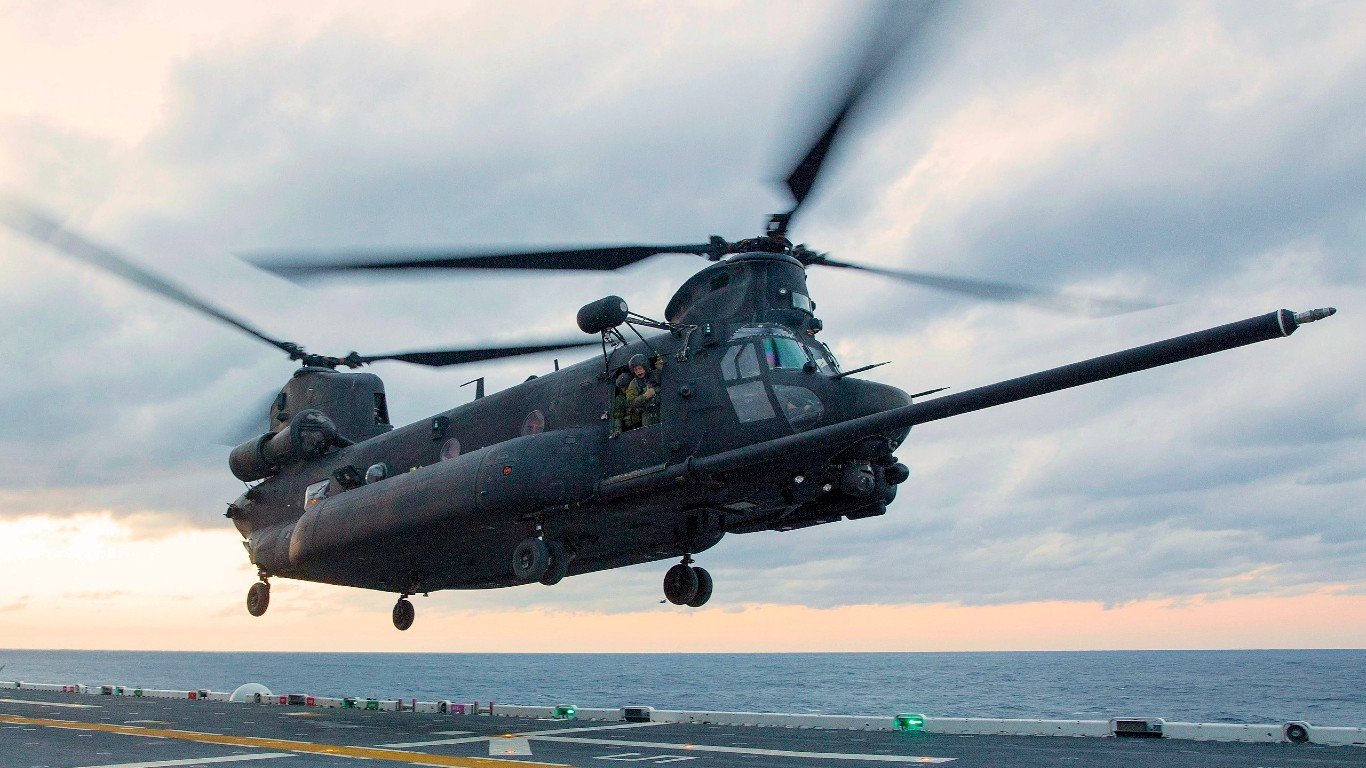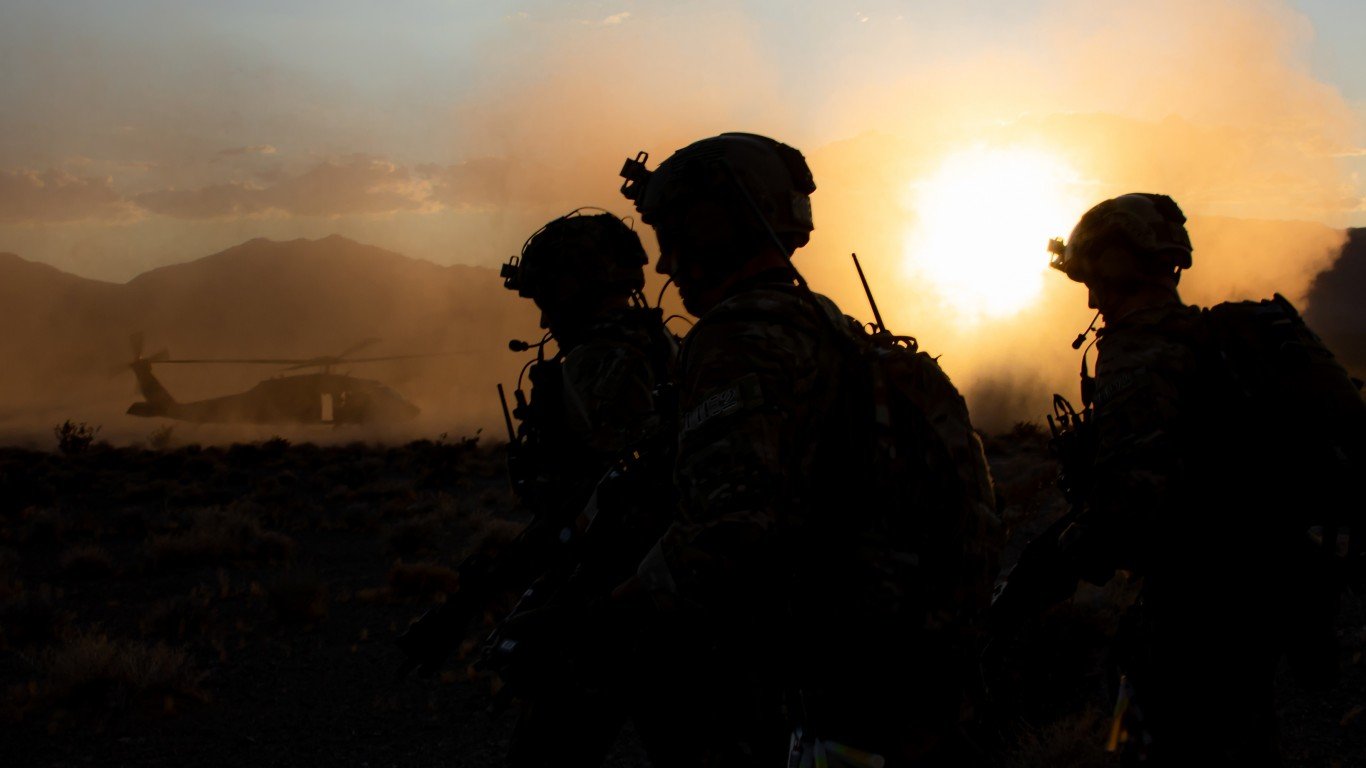
U.S. Army
> Typical duration of training: 10 weeks
The Army is the largest and oldest branch of the U.S. military, established in 1775 with approximately half a million enlisted personnel today. Army basic training typically consists of a 10 week boot camp at one of five locations: Fort Benning, Georgia, Fort Jackson, South Carolina, Fort Leonard Wood, Missouri, Fort Sill, Oklahoma, and Fort Knox, Kentucky.
Training consists of four distinct two-week phases: the Yellow Phase, in which recruits learn behavioral standards, core principles, military strategy, and first aid; Red Phase, which includes obstacle course training, rappelling exercise, and a field exercise; White Phase, which covers firearm training, hand-to-hand combat training, and a two-day, two-night field exercise; and the Blue Phase, which develops marksmanship skills, covers explosives disabling and advanced weapons training, and includes a multi-day field exercise designed to test navigation, survival, and fitness skills.
Recruits must also demonstrate a minimum level of physical fitness, measured with deadlift exercises, pushups, sprints, planks, and a 2 mile run.
[in-text-ad]

75th Ranger Regiment (Army Rangers)
> Service branch: U.S. Army
> Typical duration of training: 62 days
The basic role of the Army Rangers is to carry out raids behind enemy lines – and Army Ranger School at Fort Benning is one of the most challenging training regimens in the U.S. military. The 62-day training program is designed to push mental and physical limits. Training comprises three distinct phases: the Benning Phase, the Mountain Phase, and the Swamp Phase. Before moving on to each successive phase, students must demonstrate a mastery of specific skills learned and receive positive peer evaluations.
Benning, the first phase, lasts 21 days, and only about half of those who begin the phase are still there on the final day. On day one, aspiring Rangers must demonstrate their ability to complete 49 pushups, 59 sit-ups, six chin-ups, and a 5-mile run in under 40 minutes. In the following days, they are tested on basic navigation and soldiering skills and must complete an obstacle course known as the “worm pit” and complete a 12 mile march with a 47 pound pack. Less than half of the class typically moves past these challenges. Those who do, participate in battle drills and complete additional obstacle courses.
In the Mountain Phase, troops are trained and tested for the rigors of combat in mountainous terrain at Camp Frank D. Merrill near Dahlonega, Georgia. The program includes rope management and the fundamentals of rappelling and hauling gear up and down mountainsides and partaking in simulated combat scenarios – all while managing physical and mental fatigue, hunger, and often extreme weather.
The final Swamp Phase takes place at Camp Rudder in Eglin Air Force Base, Florida. Here, students are instructed in waterborne operations and are tested with a 10-day patrol simulation that incorporates raids, ambushes, and urban assaults. Those who make the cut move back to Fort Benning for graduation.
Special Forces (Green Berets)
> Service branch: U.S. Army
> Typical duration of training: 53 – 95 weeks
Green Berets are tasked with taking on terrorist threats in stealth, guerrilla style operations in foreign countries and are trained to be effective in a range of environments, including cities, jungles, and deserts. Green Beret training lasts over a year and begins with a rigorous six-week Special Forces Preparation Course, which focuses on physical conditioning and navigation skills. In the following three weeks, aspiring Green Berets are put through rigorous physical and mental testing to determine whether or not they would be successful candidates.
Those who clear the initial phases move on to the Qualification Course, which is broken down into six sections that focus on developing specific skills, including learning an assigned language. The course culminates with Robin Sage – a guerrilla warfare exercise spanning 15 counties in North Carolina and involving hundreds of role players. Upon completion, newly minted Green Berets move on to six months of language and culture training and hone skills in specific areas of expertise.
For those who are qualified and are considering enrolling in Green Beret training, experts advise preparing a physical training regimine. Recommended workouts include swimming up to 2,000 meters two-three times a week, running between 3 and 5 miles as fast as possible four to five times a week, marching with a 50 pound pack for 5-15 miles twice a week, and 75 to 100 pull-ups, 200 to 300 push-ups, and 200 to 300 sit-ups every other day.

SOAR – 160th Special Operations Aviation Unit (Night Stalkers)
> Service branch: U.S. Army
> Typical duration of training: 6 weeks for enlistees, 27 weeks for officers
The 160th Special Operations Aviation Unit, or SOAR, colloquially known as the Night Stalkers, serves as the aviation unit for special operations. These highly trained helicopter pilots fly modified Black Hawk, Chinook, and Little Bird helicopters into hostile territory, often to transport Navy SEALS and Delta Force teams, and they are said to be able to engage a target anywhere in the world within a 30 second window.
Minimum qualifications for those applying to join the Night Stalkers include having a Military Occupation Specialty, typically in aviation, the ability to obtain a government security clearance, be financially stable, and physically fit and successfully complete a one-week vetting process that examines flight skills, character, psychology, and demeanor – though these requirements vary for officers and enlistees. Those who meet established qualifications go on to a six-week training course in Fort Campbell, Kentucky known as Green Platoon, which covers combat, weapons, and water survival training. Green Platoon is both physically and mentally demanding.
Pilots with the Night Stalkers go on to train for several more months to develop skills for flying low over a range of varying terrain, aerial refueling, shipboard deck landing, and aerial refueling. About 60% of enlistees make it through the six week training course, and only 30%-35% of officers make it through the multiple month training course.
[in-text-ad-2]

1st Special Forces Operational Detachment-Delta (Delta Force)
> Service branch: U.S. Army
> Typical duration of training: About 6 months
Delta Force, though administratively a part of the Army, is effectively controlled by the Joint Special Operations Command, or JSOC. They are an elite unit that often operates with directions from the highest levels of government to carry out a range of operations, including direct action, counterterrorism, hostage rescue, and reconnaissance.
Delta Force members must be airborne qualified and are typically recruited directly from the 75th Ranger Regiment and the Green Berets. The secret nature of the work of Delta Force extends all the way down to training, though some aspects of the process are known – including a solitary, timed 40-mile march with a 45 pound pack that must be completed within an undisclosed time limit – as well as an all-night 18 mile navigation course with a 40 pound pack.
In addition to rigorous physical challenges, Delta Force training is also designed to test mental limits. Candidates are evaluated by review boards, psychologists, and the Delta Force commander. They are barraged with questions, and their answers are subject to exhaustive analysis designed to test mental stamina. Only about 10% of those who start Delta Force training make it through this first phase – and those who do face an additional six months in the Operator Training Course, or OTC.
In OTC, candidates have little or no contact with friends or family and are trained in advanced marksmanship, from long-range sniper shots to hitting moving targets without traditional aiming techniques. They are also taught how to build improvised explosives, rescue hostages, conduct espionage, and conduct high-risk driving maneuvers. OTC culminates with an exercise designed to test everything covered in training.




